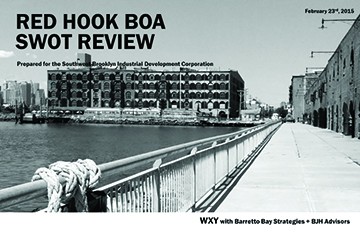 The Southwest Brooklyn Industrial Development Corporation (SBIDC) recently gave an update on the progress of the Red Hook Brownfield Opportunity Area (BOA) program at a Community Board 6 meeting.
The Southwest Brooklyn Industrial Development Corporation (SBIDC) recently gave an update on the progress of the Red Hook Brownfield Opportunity Area (BOA) program at a Community Board 6 meeting.
The Brownfield Program, which dates to the 2003 Superfund Brownfield Law, assists municipalities and community based organizations with assessing and implementing revitalization strategies for polluted areas. The program can cover up to 90 percent of eligible project costs.
If one of the sites put forward by SBIDC is selected, it could result in jobs as well as economic development.
“A good portion of the jobs are entry level,” said David Meade, executive director at SBIDC, at the meeting. “It is warehousing, drivers, electricians (non entry level) and carpenters. There is a lot of entry-level industrial work. There is also a clerical component to it, too.”
Initially 16 sites were put forward, but that number has been narrowed down to four. According to Meade, there are 38 BOA locations in process statewide and they should know within six months if one of the four sites is selected by the state.
Phases
According to the Brownfield website, the three steps in the Brownfield program include a pre-nomination study, nomination and implementation strategy. “The Implementation Strategy provides a description of the full range of techniques and actions, ranging from actions and projects that can be undertaken immediately to those that have a longer timeframe,” says the website.
SBIDC received a state contract to oversee the Red Hook BOA process in 2012.
“We are basically at the final nomination stage,” Meade said. “The funding is given to get permanent nomination and then to go into step three, which is the implementation stage.” The most important step in finalizing the properties is getting the approval from the property owners so that remediation could happen.
SBIDC initially got a sum of money for the project back in 2012 but went through it swiftly in an effort to put their plan together.
“We got $90,000 for the project in 2012,” Meade said. “We burned through it in 2013 but continued to get through the study. We had consultants that helped us with the market analysis. Our own staff time is spent getting out to community meetings. We wanted to make sure we put a good plan and nomination report together.”
Jobs
SBIDC is looking at locations in Red Hook that are vacant and underutilized, and aims to ensure that the nominated sites are resilient and can take in jobs. The three businesses that they are now focused on are located at the intersections of Coffey and Dwight Streets, Coffey and Oswego Streets and Dwight and Richards Streets.
“We are [also] looking at a Port Authority property down by the Cruise Terminal.” Meade said. “There is a trucking operation there so we are seeing if that can be developed into something else.
They were happy to report that one location, the one at Dwight and Coffey, is a strategic site that was a metal fabricator woodworker. They can bring in 20 jobs, according to Meade.
The SBIDC’s overall plan for the properties is that they have job intensive uses that are connected back to local residents or the local community.
After their economic analysis, SBIDC found that Red Hook is well-suited to manufacturing firms and commercial uses that require: regional connectivity, proximity to consumer markets, interesting building character, waterfront views and access and unique identity.
There are many benefits for businesses that are nominated.
“One of the big pieces with that is if somebody is interested in developing a property there are a series of potential tax credits that might be eligible to them,” Meade said. “They can get a break on real estate taxes. They can get a bump once the area is designated if they are creating a development that is consistent with the plan.”
The vision of the Red Hook BOA is to encourage an equitable economic development strategy for the revitalization of its area brownfields. The BOA promotes development that will create good-quality, family-supporting, manufacturing jobs that can be directly connected to local residents.








